Table of Contents
ToggleAre you struggling to convert leads into paying customers for your SaaS business? Have you tried various marketing tactics, but are still not seeing the results you desire?
It’s time to consider building a high-converting sales funnel.
A sales funnel is a step-by-step process that guides potential customers towards making a purchase. By creating a customized sales funnel for your SaaS business, you can increase conversions and ultimately boost revenue.
In this article, we will explore the key elements of a successful sales funnel and provide tips for building one that works for your business.
Understanding the Sales Funnel
The sales funnel represents the customer journey from awareness to purchase. The horn is divided into stages corresponding to the customer’s mindset and actions.
- The first stage is awareness, where the customer becomes aware of the product or service through marketing efforts such as social media, advertising, or content marketing.
- The second stage is fascinating, where the customer expresses interest in the product or service and begins researching more information.
- The third stage is a consideration, where the customer evaluates the product or service and compares it to competitors.
- The fourth stage is a decision, where the customer decides to purchase.
- The final stage is retention, where the customer continues using the product or service, becomes loyal, and may even refer others.
Understanding the sales funnel is essential for businesses because it helps them understand the customer journey and optimize their marketing efforts accordingly. By analyzing the funnel, companies can identify areas for improvement, such as increasing awareness or improving the decision stage.
Furthermore, businesses can use the funnel to segment customers based on their stage in the journey and tailor their messaging and marketing efforts accordingly. Understanding the sales funnel is crucial for businesses to optimize their marketing efforts and improve customer acquisition and retention.
Sales funnel and its stages
The sales funnel represents the customer journey from initial awareness to final purchase. The horn is divided into stages corresponding to the customer’s mindset and actions.
- The first stage is the awareness stage, where potential customers become aware of the product or service through marketing efforts such as social media, advertising, or content marketing.
- The second stage is the interest stage, where customers show interest in the product or service and begin researching more information.
- The third stage is the consideration stage, where customers evaluate the product or service and compare it to competitors.
- The fourth stage is the decision stage, where customers decide whether to make a purchase or not.
- The final stage is the retention stage, where businesses work to retain customers and encourage repeat purchases.
Each stage of the sales funnel requires different marketing efforts and strategies. In the awareness stage, businesses must focus on brand building and generating interest. Companies must provide more detailed information and address potential concerns in the interest and consideration stages.
Businesses must provide a clear call to action in the decision stage and encourage customers to purchase. In the retention stage, companies must provide excellent customer service and continue to provide value to keep the customer returning.
By understanding the stages of the sales funnel and tailoring their marketing efforts accordingly, businesses can improve their customer acquisition and retention rates and overall sales performance.
Importance of understanding the sales funnel for optimizing conversions
Understanding the sales funnel is critical for optimizing conversions and improving overall sales performance. By analyzing the customer journey from awareness to purchase, businesses can identify areas where potential customers drop off and optimize their marketing efforts accordingly.
For example, suppose a business finds a high drop-off rate in the consideration stage. In that case, it may need to provide more detailed information about its product or service or address common concerns. Alternatively, if they have a high drop-off rate in the decision stage, they may need to provide a clearer call-to-action or offer incentives to encourage customers to make a purchase.
Furthermore, by understanding the sales funnel, businesses can segment their customers and tailor their marketing efforts accordingly. For example, customers in the awareness stage may require different messaging than those in the consideration stage.
By tailoring messaging and marketing efforts to each funnel stage, businesses can improve the overall customer experience and increase the likelihood of conversions.
Understanding the sales funnel is essential for optimizing conversions and improving overall sales performance. By analyzing the customer journey, identifying areas for improvement, and tailoring marketing efforts, businesses can increase their conversion rates, acquire more customers, and ultimately drive growth.
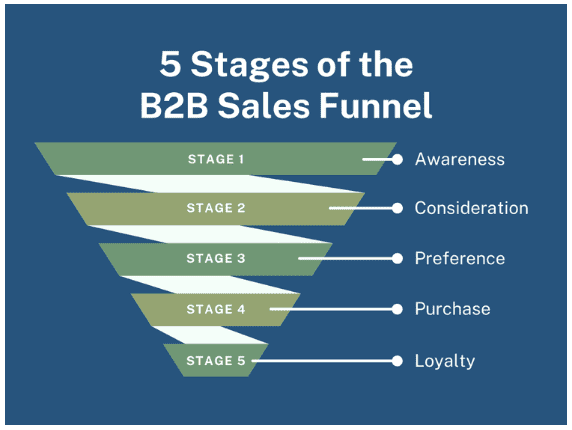
Sales Funnel Stages
The sales funnel visually represents the customer journey from initial awareness to final purchase. It is divided into several stages, each with a unique focus and set of actions.
- Awareness: In this stage, customers become aware of the product or service through various marketing efforts such as social media, advertising, or content marketing.
- Interest: In this stage, customers show interest in the product or service and research more information. They may visit the business’s website, read reviews, or compare different options.
- Consideration: In this stage, customers evaluate the product or service and compare it to competitors. They may request a demo or consultation, ask questions, or seek more information to make an informed decision.
- Decision: In this stage, customers decide to make a purchase. They may add items to their cart, fill out a form, or complete the checkout process.
- Retention: In this stage, businesses work to retain customers and encourage repeat purchases. They may offer incentives, provide excellent customer service, or send follow-up emails to keep the customer engaged.
Each sales funnel stage requires a different focus and set of actions. By understanding the phases and tailoring marketing efforts accordingly, businesses can improve their overall sales performance and increase customer acquisition and retention rates.
Explanation of each stage of the sales funnel
The sales funnel represents the customer journey from initial awareness to final purchase. The horn is divided into several stages, each with a unique focus and set of actions.
- Awareness: In this stage, customers become aware of the product or service through various marketing efforts such as social media, advertising, or content marketing. This stage aims to generate interest and make potential customers aware of the business and its offerings.
- Interest: In this stage, customers show interest in the product or service and research more information. They may visit the business’s website, read reviews, or compare different options. This stage aims to provide more information and build trust with potential customers.
- Consideration: In this stage, customers evaluate the product or service and compare it to competitors. They may request a demo or consultation, ask questions, or seek more information to make an informed decision. This stage addresses any concerns or queries and provides a clear value proposition.
- Decision: In this stage, customers decide to make a purchase. They may add items to their cart, fill out a form, or complete the checkout process. This stage aims to provide a clear call to action and make the purchasing process as smooth and easy as possible.
- Retention: In this stage, businesses work to retain customers and encourage repeat purchases. They may offer incentives, provide excellent customer service, or send follow-up emails to keep the customer engaged. This stage aims to provide ongoing value and build a loyal customer base.
By understanding each stage of the sales funnel, businesses can tailor their marketing efforts and optimize their sales performance. By addressing potential concerns, providing clear value propositions, and delivering excellent customer service, companies can increase customer acquisition and retention rates and ultimately drive growth.
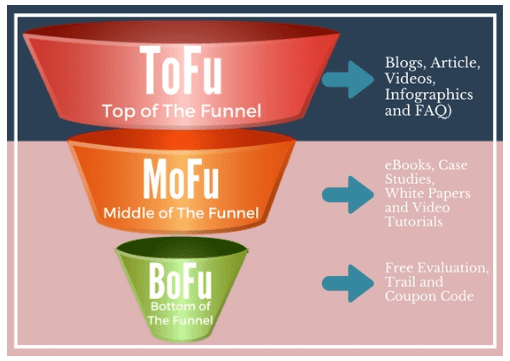
Top of Funnel (TOFU), Middle of Funnel (MOFU), and Bottom of Funnel (BOFU)
The sales funnel often divided into three sections: Top of Funnel (TOFU), Middle of Funnel (MOFU), and Bottom of Funnel (BOFU). Each section represents a different customer journey stage and requires different marketing strategies.
- Top of Funnel (TOFU): This stage represents the awareness stage of the customer journey. TOFU marketing aims to attract potential customers through various marketing efforts such as social media, content marketing, and advertising. The focus is on generating interest and building awareness of the company and its offerings.
- Middle of Funnel (MOFU): This stage represents the consideration stage of the customer journey. MOFU marketing aims to provide more detailed information about the business and its offerings and build trust with potential customers. Strategies may include providing free resources such as whitepapers, webinars, or consultations.
- Bottom of Funnel (BOFU): This stage represents the decision stage of the customer journey. BOFU marketing aims to encourage potential customers to purchase or take action. Strategies may include discounts, free trials, or clear calls to action.
By understanding the different stages of the sales funnel and tailoring marketing efforts accordingly, businesses can improve customer acquisition and retention rates and overall sales performance. Companies can use TOFU, MOFU, and BOFU marketing strategies to attract potential customers, provide value, build trust, and drive growth.
Metrics for Measuring Sales Funnel Success
Measuring the success of a sales funnel is essential for businesses to identify areas for improvement and optimize their marketing efforts. There are several metrics that companies can use to measure the success of their sales funnel:
- Conversion rate: This metric measures the percentage of visitors who complete a desired action, such as purchasing or filling out a form. A high conversion rate indicates that the sales funnel effectively guides customers through the customer journey.
- Cost per acquisition (CPA): This metric measures the cost of acquiring a new customer. By analyzing CPA, businesses can determine the effectiveness of their marketing efforts and adjust their budget and strategies accordingly.
- Customer lifetime value (CLV): This metric measures the total value a customer brings to a business over their lifetime. By understanding CLV, companies can determine the ROI of their marketing efforts and prioritize customer retention strategies.
- Churn rate: This metric measures the percentage of customers who stop using a product or service. A high churn rate can indicate that the sales funnel or customer experience needs improvement.
- Time to conversion: This metric measures the time it takes for a customer to move through the sales funnel and make a purchase. By reducing time to conversion, businesses can increase their overall sales performance.
By analyzing these metrics, businesses can identify areas for improvement and optimize their sales funnel to improve their overall customer acquisition and retention rates. It’s essential to continually monitor and optimize the sales funnel to drive growth and improve business performance.
Key performance indicators (KPIs) for each stage of the sales funnel
Key performance indicators (KPIs) are important metrics that help businesses measure the success of their sales funnel. Here are some KPIs for each stage of the sales funnel:
Top of Funnel (TOFU) KPIs:
- Traffic volume: measures the number of visitors to the business’s website or social media pages.
- Social media engagement: measures the level of attention, such as likes, comments, and shares, on social media posts.
- Click-through rate (CTR): measures the percentage of people who click on an advertisement or social media post and visit the business’s website.
Middle of Funnel (MOFU) KPIs:
- Form conversion rate: measures the percentage of visitors who complete a form to download a resource or sign up for a consultation.
- Email open rate: measures the percentage of email recipients who open the email.
- Webinar attendance rate: measures the percentage of registrants who attend the webinar.
Bottom of Funnel (BOFU) KPIs:
- Conversion rate: measures the percentage of visitors who purchase or take a desired action.
- Average order value (AOV): measures the average value of each customer’s purchase.
- Cart abandonment rate: measures the percentage of customers who add items to their cart but still need to complete the checkout process.
By tracking these KPIs, businesses can gain insight into the effectiveness of their sales funnel at each stage and identify areas for improvement. It’s essential to continually monitor and optimize the sales funnel to drive growth and improve overall business performance.
Importance of tracking and analyzing metrics for optimizing conversions
Tracking and analyzing metrics is crucial for optimizing conversions and improving overall sales performance. Businesses can identify areas where potential customers drop off by analyzing data and optimizing their marketing efforts accordingly.
For example, suppose a business finds a high drop-off rate in the consideration stage. In that case, it may need to provide more detailed information about its product or service or address common concerns. Alternatively, if they have a high drop-off rate in the decision stage, they may need to provide a clearer call-to-action or offer incentives to encourage customers to purchase.
By tailoring messaging and marketing efforts to each funnel stage, businesses can improve the overall customer experience and increase the likelihood of conversions. Furthermore, by tracking and analyzing metrics, companies can segment their customers and tailor their marketing efforts accordingly. For example, customers in the awareness stage may require different messaging than those in the consideration stage.
Tracking and analyzing metrics is essential for optimizing conversions and improving overall sales performance. By identifying areas for improvement, tailoring marketing efforts, and delivering excellent customer service, businesses can increase customer acquisition and retention rates and ultimately drive growth.
Strategies for Building a High-Converting Sales Funnel
Building a high-converting sales funnel is crucial for businesses to increase customer acquisition, retention rates, and overall sales performance. Here are some strategies for building a high-converting sales funnel:
- Identify the target audience: Understanding the target audience is critical for building a sales funnel that resonates with potential customers. Businesses can tailor messaging and marketing efforts to appeal to their ideal customers by analyzing demographics, interests, and behavior.
- Provide value at every stage: Every step of the sales funnel is essential to build trust with potential customers. Businesses can demonstrate their expertise by offering free resources such as whitepapers, webinars, consultations, and building relationships with potential customers.
- Optimize for mobile: With more and more people using mobile devices to browse the internet, optimizing the sales funnel for mobile is essential. By ensuring that the website and checkout process are mobile-friendly, businesses can provide a seamless customer experience and increase the likelihood of conversions.
- Use clear calls-to-action: Providing clear calls-to-action throughout the sales funnel is critical for encouraging potential customers to take action. Businesses can increase the likelihood of conversions by using robust and straightforward language and highlighting the benefits of taking action.
- Test and optimize: Continuously testing and optimizing the sales funnel is essential for improving its effectiveness. Businesses can optimize their marketing efforts and increase conversions by analyzing data and identifying areas for improvement.
Building a high-converting sales funnel requires understanding the target audience, providing value at every stage, optimizing for mobile, using clear calls-to-action, and continuously testing and optimizing the funnel. By following these strategies, businesses can increase customer acquisition and retention rates, ultimately driving growth.
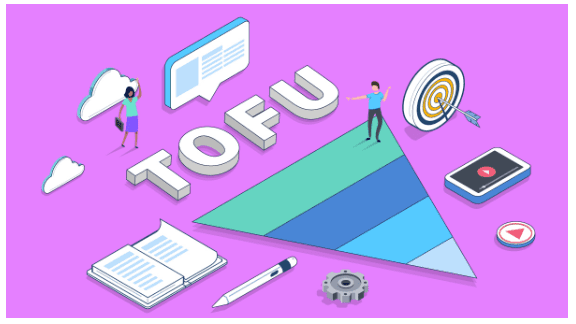
Top of Funnel (TOFU)
Top of the funnel (TOFU) is the first stage of the sales funnel, where potential customers become aware of the business and its offerings. TOFU marketing aims to attract potential customers through various marketing efforts such as social media, content marketing, and advertising.
Here are some strategies for building an effective TOFU:
- Define the target audience: Understanding the target audience is critical for building an effective TOFU. Businesses can tailor messaging and marketing efforts to appeal to their ideal customers by analyzing demographics, interests, and behavior.
- Create valuable content: Providing valuable content is essential for building trust with potential customers and generating interest in the business. Companies can establish themselves as an authority in their industry by creating content that educates, entertains, or solves a problem for potential customers.
- Use social media: Social media is a powerful tool for building brand awareness and attracting potential customers to the business. Businesses can generate interest and make a following by creating engaging social media posts, sharing valuable content, and interacting with potential customers.
- Use paid advertising: Paid advertising effectively reaches a larger audience and generates more leads. Businesses can target potential customers based on demographics, interests, or behavior using Google Ads, Facebook Ads, or LinkedIn Ads.
- Offer incentives: Offering incentives such as free resources or discounts is a great way to encourage potential customers to engage with the business and provide contact information for future marketing efforts.
By following these strategies, businesses can build an effective TOFU that attracts potential customers and generates interest in the industry and its offerings.
Creating awareness through targeted marketing and advertising
Creating awareness through targeted marketing and advertising is essential to building an effective sales funnel. Targeted marketing and advertising allow businesses to reach potential customers more likely to be interested in their offerings.
Here are some strategies for creating awareness through targeted marketing and advertising:
- Define the target audience: Understanding the target audience is critical for creating targeted marketing and advertising campaigns. Businesses can tailor messaging and marketing efforts to appeal to their ideal customers by analyzing demographics, interests, and behavior.
- Use social media: Social media is a powerful tool for building brand awareness and reaching potential customers. By creating engaging social media posts and targeting options, businesses can reach potential customers more likely to be interested in their offerings.
- Use pay-per-click (PPC) advertising: PPC advertising allows businesses to reach potential customers actively searching for similar products or services. Using platforms such as Google Ads or Bing Ads, companies can target potential customers based on keywords and demographics.
- Use display advertising: Display advertising allows businesses to reach potential customers through visual ads on websites or apps. Using Google Display Network or Facebook Audience Network, companies can target potential customers based on interests, behavior, or demographics.
- Offer incentives: Offering incentives such as free resources or discounts is a great way to encourage potential customers to engage with the business and provide contact information for future marketing efforts.
By following these strategies, businesses can create awareness through targeted marketing and advertising and reach potential customers more likely to be interested in their offerings.
Building a list of leads for nurturing
Building a list of leads for nurturing is essential to building an effective sales funnel. Nurturing leads allows businesses to build relationships with potential customers and guide them through the customer journey. Here are some strategies for building a list of leads for boosting:
- Create valuable content: Providing valuable content such as whitepapers, webinars, or e-books is a great way to attract potential customers and encourage them to provide contact information for future marketing efforts.
- Use lead magnets: Lead magnets such as free trials or demos are a great way to encourage potential customers to provide contact information and engage with the business.
- Use landing pages: Landing pages are dedicated pages designed to capture contact information from potential customers. By using clear, concise language and offering value in exchange for contact information, businesses can encourage potential customers to provide their input.
- Use social media: Social media is a powerful tool for building relationships with potential customers and encouraging them to provide contact information. By creating engaging social media posts and offering valuable content, businesses can encourage potential customers to engage with the company and provide contact information.
- Use paid advertising: Paid advertising effectively reaches a larger audience and generates more leads. By using platforms such as Google Ads or Facebook Ads, businesses can target potential customers and encourage them to provide contact information.
By following these strategies, businesses can build a list of leads for nurturing and guiding potential customers through the customer journey. Nurturing leads is essential for building relationships, providing value, and ultimately driving growth.
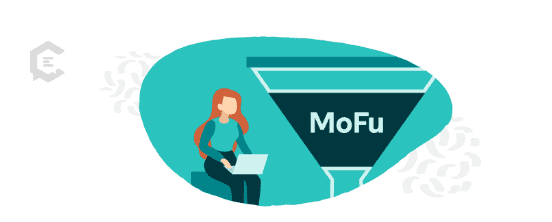
Middle of Funnel (MOFU)
Middle of Funnel (MOFU) is the second stage of the sales funnel, where potential customers have shown interest in the business and its offerings. MOFU marketing aims to provide more detailed information about the company and its offerings and build trust with potential customers. Here are some strategies for building an effective MOFU:
- Provide valuable resources: Providing valuable resources such as whitepapers, case studies, or webinars is a great way to educate potential customers about the business and its offerings. By providing detailed information, companies can establish themselves as an authority in their industry and build trust with potential customers.
- Use email marketing: Email marketing is an effective way to nurture leads and provide targeted messaging to potential customers. By segmenting charges based on behavior and interests, businesses can tailor messaging to each group and provide more personalized information.
- Use retargeting: Retargeting allows businesses to show ads to potential customers who have shown interest in the company or its offerings. Using platforms such as Google Ads or Facebook Ads, businesses can target potential customers who have visited the website or engaged with the business on social media.
- Use case studies: Case studies are a great way to provide detailed information about how the business has helped other customers in similar situations. Using case studies, companies can demonstrate the value of their offerings and build trust with potential customers.
- Use consultations: Consultations allow businesses to provide personalized information and answer specific questions from potential customers. By providing valuable information and demonstrating expertise, companies can build trust with potential customers and increase the likelihood of conversions.
By following these strategies, businesses can build an effective MOFU that provides valuable information, builds trust with potential customers, and increases the likelihood of conversions.
Nurturing leads with targeted content and communications
Nurturing leads with targeted content and communications is essential to building an effective sales funnel. Businesses can build relationships and guide them through the customer journey by providing valuable content and personalized messaging to potential customers.
Here are some strategies for nurturing leads with targeted content and communications:
- Use email marketing: Email marketing is an effective way to provide targeted messaging to potential customers. By segmenting leads based on behavior and interests, businesses can tailor messaging to each group and provide more personalized information.
- Use marketing automation: Marketing automation allows businesses to send personalized messages to potential customers based on their behavior and interactions with the company. Businesses can build relationships and guide potential customers through the journey by automating messaging and providing relevant content.
- Use personalization: Personalization allows businesses to provide more targeted messaging and make potential customers feel valued. By using personalized messaging and content, companies can build relationships and increase the likelihood of conversions.
- Use retargeting: Retargeting allows businesses to show ads to potential customers who have shown interest in the company or its offerings. Using platforms such as Google Ads or Facebook Ads, businesses can target potential customers who have visited the website or engaged with the business on social media.
- Use social media: Social media is a powerful tool for building relationships with potential customers and providing personalized messaging. By engaging with potential customers on social media and providing valuable content, businesses can build relationships and increase the likelihood of conversions.
By following these strategies, businesses can nurture leads with targeted content and communications and guide potential customers through the customer journey. Nurturing leads is essential for building relationships, providing value, and ultimately driving growth.
Providing educational materials and demonstrating the value
Providing educational materials and demonstrating value are essential to building an effective sales funnel. By providing valuable information and demonstrating expertise, businesses can build trust with potential customers and increase the likelihood of conversions.
Here are some strategies for providing educational materials and demonstrating value:
- Use content marketing: Content marketing is a great way to provide valuable information to potential customers and demonstrate expertise. By creating blog posts, whitepapers, or e-books, businesses can educate potential customers and establish themselves as an authority in their industry.
- Use webinars: Webinars are a great way to provide detailed information about the business and its offerings and answer specific questions from potential customers. By providing valuable information and demonstrating expertise, companies can build trust with potential customers and increase the likelihood of conversions.
- Use case studies: Case studies are a great way to demonstrate the value of the business and its offerings. By providing detailed information about how the industry has helped other customers in similar situations, companies can build trust with potential customers and increase the likelihood of conversions.
- Use testimonials: Testimonials are a powerful tool for demonstrating value and building trust with potential customers. By sharing feedback from satisfied customers, businesses can show the value of their offerings and increase the likelihood of conversions.
- Use consultations: Consultations allow businesses to provide personalized information and answer specific questions from potential customers. By providing valuable information and demonstrating expertise, companies can build trust with potential customers and increase the likelihood of conversions.
By following these strategies, businesses can provide educational materials and demonstrate value to potential customers, building trust and increasing the likelihood of conversions. Providing valuable information and demonstrating expertise is essential for building relationships, providing value, and ultimately driving growth.
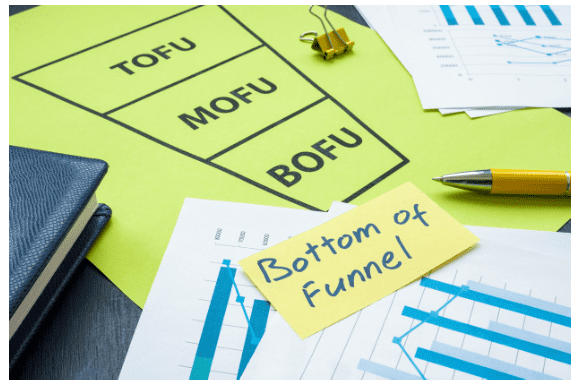
Bottom of Funnel (BOFU)
The bottom of the Funnel (BOFU) is the final stage of the sales funnel, where potential customers are ready to make a purchase decision. BOFU marketing aims to encourage potential customers to purchase and convert into paying customers. Here are some strategies for building an effective BOFU:
- Use retargeting: Retargeting allows businesses to show ads to potential customers who have shown interest in the company or its offerings. Using platforms such as Google Ads or Facebook Ads, businesses can target potential customers who have visited the website or engaged with the business on social media and provide targeted messaging to encourage conversions.
- Use personalized messaging: Personalized messaging allows businesses to provide targeted messaging and make potential customers feel valued. By using customized messaging and offering discounts or special offers, companies can encourage potential customers to purchase.
- Use clear calls-to-action: Providing clear calls-to-action throughout the BOFU is critical for encouraging potential customers to take action. Businesses can increase the likelihood of conversions by using robust and straightforward language and highlighting the benefits of purchasing.
- Use customer reviews and ratings: Customer reviews and ratings are a powerful tool for building trust and encouraging potential customers to purchase. By displaying positive feedback from satisfied customers, businesses can demonstrate the value of their offerings and increase the likelihood of conversions.
- Use abandoned cart emails: Abandoned cart emails are a great way to encourage potential customers to complete their purchases. By sending personalized emails highlighting the items left in the cart and offering incentives such as discounts or free shipping, businesses can encourage potential customers to complete their purchases.
By following these strategies, businesses can build an effective BOFU that encourages potential customers to purchase and convert into paying customers. Encouraging conversions is essential for driving growth and increasing revenue.
Offering a free trial or demo of your product or service
Offering a free trial or demo of your product or service is a great way to encourage potential customers to try your offerings and convert them into paying customers. Here are some strategies for offering a free trial or demo:
- Define the trial or demo period: Defining the problem or demo period is critical for managing expectations and encouraging potential customers to try the offering. By setting a clear start and end date, businesses can encourage potential customers to take action and provide feedback.
- Provide clear instructions: Providing clear instructions on accessing and using the trial or demo is critical for making the process easy and seamless for potential customers. By providing step-by-step instructions and support, businesses can reduce confusion and increase the likelihood of conversions.
- Use email marketing: Email marketing is an effective way to follow up with potential customers and encourage them to convert into paying customers. By providing targeted messaging and offering incentives such as discounts or special offers, businesses can encourage potential customers to purchase.
- Use personalized messaging: Personalized messaging allows businesses to provide targeted messaging and make potential customers feel valued. By using customized messaging and highlighting the benefits of the offering, companies can encourage potential customers to convert into paying customers.
- Provide support: Support during the trial or demo period is critical for building relationships and encouraging potential customers to convert into paying customers. Businesses can demonstrate expertise and build trust with potential customers by offering support and answering questions.
By following these strategies, businesses can offer a free trial or demo of their product or service and encourage potential customers to convert into paying customers. Offering a free trial or demo is an effective way to demonstrate the value of the offering and ultimately drive growth and increase revenue.
Making the purchase process easy and streamlined
Making the purchase process easy and streamlined is critical for encouraging potential customers to convert into paying customers. Here are some strategies for making the purchase process easy and streamlined:
- Use a clear and simple checkout process: Using a clear and simple checkout process is critical for reducing confusion and increasing the likelihood of conversions. Businesses can make the purchase process easy and streamlined by providing a step-by-step process and offering multiple payment options.
- Use a mobile-friendly website: A mobile-friendly website is critical for providing a seamless experience for potential customers. By optimizing the website for mobile devices, businesses can make the purchase process easy and streamlined for customers.
- Use clear and concise language: Using clear and concise language throughout the purchase process is critical for reducing confusion and increasing the likelihood of conversions. Businesses can simplify the purchase process by using simple language and avoiding technical jargon.
- Offer support: Offering support during purchase is critical for reducing confusion and building trust with potential customers. By providing support and answering questions, businesses can demonstrate expertise and increase the likelihood of conversions.
- Use retargeting: Retargeting allows businesses to show ads to potential customers who have shown interest in the company or its offerings. Using platforms such as Google Ads or Facebook Ads, businesses can target potential customers who have abandoned the checkout process and encourage them to complete their purchases.
By following these strategies, businesses can simplify the purchase process for potential customers and increase the likelihood of conversions. Making the purchase process easy and streamlined is essential for driving growth and increasing revenue.

Post-Sale
Post-sale is an essential stage of the sales funnel, where businesses can build relationships with customers and encourage repeat purchases. Here are some strategies for building an effective post-sale process:
- Use customer feedback: Gathering feedback from customers is critical for understanding their needs and improving the business. Companies can gather valuable insights and improve the customer experience by using surveys or feedback forms.
- Use personalized messaging: Personalized messaging allows businesses to provide targeted messaging and make customers feel valued. Companies can encourage repeat purchases and build loyalty by using personalized messaging and offering incentives such as discounts or special offers.
- Provide support: Providing support after the sale is critical for building relationships and demonstrating expertise. By offering support and answering questions, businesses can build customer trust and increase the likelihood of repeat purchases.
- Use social media: Social media is a powerful tool for building relationships with customers and encouraging repeat purchases. By engaging with customers on social media and providing valuable content, businesses can build relationships and encourage repeat purchases.
- Use loyalty programs: Loyalty programs are a great way to encourage repeat purchases and build loyalty. By offering rewards or discounts to customers who make repeat purchases, businesses can incentivize customers to continue doing business with the company.
By following these strategies, businesses can build an effective post-sale process that encourages repeat purchases and builds loyalty. Building relationships with customers is essential for driving growth and increasing revenue.
Ensuring customer satisfaction and retention
Ensuring customer satisfaction and retention is critical for building long-term customer relationships and driving business growth. Here are some strategies for ensuring customer satisfaction and retention:
- Provide excellent customer service: Providing excellent customer service is critical for customer satisfaction and retention. Businesses can build customer trust and encourage repeat purchases by offering support and answering questions in a timely and friendly manner.
- Use customer feedback: Gathering feedback from customers is critical for understanding their needs and improving the business. Companies can gather valuable insights and improve the customer experience by using surveys or feedback forms.
- Use personalized messaging: Personalized messaging allows businesses to provide targeted messaging and make customers feel valued. Companies can encourage repeat purchases and build loyalty by using personalized messaging and offering incentives such as discounts or special offers.
- Use loyalty programs: Loyalty programs are a great way to encourage repeat purchases and build loyalty. By offering rewards or discounts to customers who make repeat purchases, businesses can incentivize customers to continue doing business with the company.
- Use upselling and cross-selling: Upselling and cross-selling allow businesses to offer additional products or services to customers who have already purchased. Companies can increase the likelihood of repeat purchases and build loyalty by providing relevant products or services that meet the customer’s needs.
By following these strategies, businesses can ensure customer satisfaction and retention, building long-term customer relationships and driving growth. Ensuring customer satisfaction and retention is essential for building a successful business and increasing revenue.
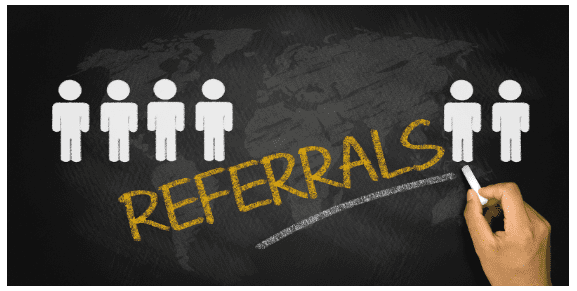
Encouraging referrals and advocacy
Encouraging referrals and advocacy is an effective way to build customer relationships and drive business growth. Here are some strategies for promoting referrals and advocacy:
- Provide excellent customer service: Providing excellent customer service is critical for encouraging referrals and advocacy. By offering support and answering questions in a timely and friendly manner, businesses can build trust with customers and encourage them to refer others to the company.
- Use referral programs: Referral programs are a great way to encourage customers to refer others to the business. By offering rewards or discounts to customers who refer others, companies can incentivize customers to share their positive experiences with others.
- Use customer reviews and ratings: Customer reviews and ratings are a powerful tool for building trust and encouraging referrals and advocacy. By displaying positive feedback from satisfied customers, businesses can demonstrate the value of their offerings and increase the likelihood of referrals and advocacy.
- Use social media: Social media is a powerful tool for building customer relationships and encouraging referrals and advocacy. By engaging with customers on social media and providing valuable content, businesses can build relationships and encourage customers to share their positive experiences with others.
- Use advocacy programs: Advocacy programs are a great way to encourage customers to become advocates for the business. By offering rewards or recognition to customers who promote the industry, companies can build a community of advocates who can help drive growth and increase revenue.
By following these strategies, businesses can encourage referrals and advocacy, building a community of satisfied customers who can help drive growth and increase revenue. Encouraging referrals and advocacy is essential for building a successful business and growing revenue.
Optimization and Testing
Optimization and testing are essential for building an effective sales funnel that drives growth and increases revenue. Here are some strategies for optimization and testing:
- Use A/B testing: A/B testing allows businesses to test different variations of their website or marketing materials to see which performs better. By testing different messaging, designs, or offers, companies can identify the best-performing elements and make improvements that drive growth and increase revenue.
- Use heatmaps: Heatmaps allow businesses to see how potential customers interact with their website or marketing materials. Using heatmaps, companies can identify areas where potential customers are spending the most time and make improvements that enhance the customer experience and increase the likelihood of conversions.
- Use conversion rate optimization (CRO): Conversion rate optimization (CRO) is optimizing the sales funnel to increase the likelihood of conversions. By using data-driven insights and making targeted improvements to the sales funnel, businesses can increase the likelihood of conversions and drive growth and revenue.
- Use analytics: Analytics allows businesses to track the performance of their sales funnel and make data-driven decisions. By monitoring metrics such as traffic, engagement, and conversions, companies can identify areas for improvement and make targeted improvements that drive growth and revenue.
- Use customer feedback: Gathering feedback from customers is critical for understanding their needs and improving the business. By using surveys or feedback forms, companies can gather valuable insights and make improvements that enhance the customer experience and increase the likelihood of conversions.
By following these strategies, businesses can optimize and test their sales funnel, making targeted improvements that drive growth and increase revenue. Optimization and testing are essential for building a successful sales funnel and ensuring long-term success for the business.
Conversion Rate Optimization (CRO)
Conversion rate optimization (CRO) is optimizing a website or sales funnel to increase the likelihood of conversions. CRO aims to improve the customer experience and make it easier for potential customers to convert into paying customers. Here are some strategies for implementing CRO:
- Use clear and compelling calls-to-action: Using clear and persuasive calls-to-action throughout the sales funnel is critical for encouraging potential customers to take action. Businesses can increase the likelihood of conversions by using strong, straightforward language and highlighting the benefits of taking action.
- Use targeted messaging: Providing targeted messaging that speaks directly to the needs and interests of potential customers is critical for encouraging conversions. By using language and imagery that resonates with potential customers, businesses can build trust and increase the likelihood of conversions.
- Use social proof: Social proof, such as customer reviews and ratings, is a powerful tool for building trust and encouraging conversions. By displaying positive feedback from satisfied customers, businesses can demonstrate the value of their offerings and increase the likelihood of conversions.
- Use optimized forms: Optimizing forms is critical for reducing friction and making it easy for potential customers to complete their purchases. Businesses can increase the likelihood of conversions by using a simple, easy-to-use form that only asks for essential information.
- Use A/B testing: A/B testing allows businesses to test different website or sales funnel variations to see which performs better. Companies can identify the best-performing elements by testing different messaging, designs, or offers and make improvements that drive growth and revenue.
By implementing these strategies, businesses can optimize their sales funnel and increase the likelihood of conversions. CRO is critical for building a successful business and driving growth and revenue.
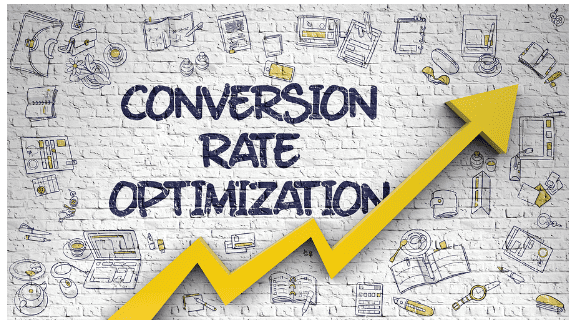
Importance of CRO for optimizing conversions
Conversion rate optimization (CRO) is important for optimizing conversions because it helps businesses improve the customer experience and make it easier for potential customers to convert into paying customers. By implementing CRO strategies, businesses can increase the likelihood of conversions and ultimately drive growth and revenue.
- CRO is essential for businesses because it helps them understand their customers and their behavior. By analyzing data and making data-driven decisions, businesses can identify areas where potential customers are dropping off and make targeted improvements to the sales funnel that address these issues.
- CRO also helps businesses stay competitive in their industry. Businesses can continuously optimize their sales funnel to improve the customer experience and stand out from their competitors. By providing a seamless and easy experience for potential customers, businesses can increase the likelihood of conversions and ultimately drive growth and revenue.
- In addition, CRO helps businesses make the most of their marketing efforts. By improving the conversion rate, businesses can increase their marketing campaigns’ return on investment (ROI) and drive more revenue.
CRO is important for optimizing conversions and driving growth and revenue for businesses. By continuously analyzing data, making data-driven decisions, and implementing targeted improvements, businesses can improve the customer experience and increase the likelihood of conversions.
Best practices for CRO in a sales funnel
Here are some best practices for implementing CRO in a sales funnel:
- Define clear goals: It is important to define clear goals for your sales funnel and CRO efforts. This helps you focus on the most important metrics and make data-driven decisions that align with your business objectives.
- Analyze data: Analyzing data is essential for understanding your customers and identifying areas for improvement in your sales funnel. By tracking metrics such as traffic, engagement, and conversions, you can identify areas where potential customers are dropping off and make targeted improvements to the sales funnel.
- Use A/B testing: A/B testing allows you to test different website variations or sales funnel variations to see which performs better. By testing different messaging, designs, or offers, you can identify the best-performing elements and make improvements that drive growth and revenue.
- Use clear and compelling calls-to-action: Using clear and persuasive calls-to-action throughout the sales funnel is critical for encouraging potential customers to take action. Using robust and clear language and highlighting the benefits of taking action can increase the likelihood of conversions.
- Use targeted messaging: Providing targeted messaging that speaks directly to the needs and interests of potential customers is critical for encouraging conversions. Using language and imagery that resonates with potential customers can build trust and increase the likelihood of conversions.
- Use social proof: Social proof, such as customer reviews and ratings, is a powerful tool for building trust and encouraging conversions. By displaying positive feedback from satisfied customers, you can demonstrate the value of your offerings and increase the likelihood of conversions.
- Use optimized forms: Optimizing forms is critical for reducing friction and making it easy for potential customers to complete their purchases. A simple, easy-to-use format that only asks for essential information increases the likelihood of conversions.
By following these best practices, businesses can implement effective CRO strategies that improve the customer experience, increase conversions, and drive growth and revenue.
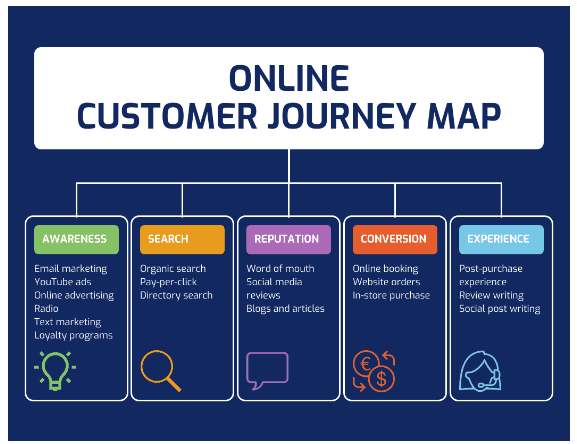
Customer Journey Mapping
Customer journey mapping visualizes the entire customer experience, from the first interaction with the business to the final purchase. By mapping the customer journey, companies can understand their customers’ needs and pain points and make targeted improvements to the sales funnel that enhance the customer experience and increase the likelihood of conversions.
Here are the steps to creating a customer journey map:
- Identify customer touchpoints: Start by identifying all the touchpoints where customers interact with your business, including your website, social media, customer service, and sales team.
- Define customer personas: Define customer personas based on demographic data, behavior, and motivations. This helps you understand the different needs and pain points of different customer segments.
- Map the journey: The customer journey from the first interaction with your business to the final purchase. This includes all the touchpoints and interactions with your business, as well as the emotions and motivations of the customer at each stage.
- Identify pain points and opportunities: Identify pain points in the customer journey where potential customers are dropping off or experiencing friction, as well as opportunities to improve the customer experience and increase the likelihood of conversions.
- Make improvements: Use the insights from your customer journey map to make targeted improvements to the sales funnel, such as optimizing forms, providing targeted messaging, or offering incentives to encourage conversions.
By creating a customer journey map, businesses can understand their customers’ needs and pain points and make targeted improvements to the sales funnel that enhance the customer experience and increase the likelihood of conversions. Customer journey mapping is essential for building a successful business and driving growth and revenue.
Importance of customer journey mapping for optimizing conversions
Customer journey mapping is essential for optimizing conversions because it helps businesses understand their customers’ needs and pain points and make targeted improvements to the sales funnel that enhance the customer experience and increase the likelihood of conversions.
By mapping the entire customer journey, businesses can identify areas where potential customers are dropping off or experiencing friction and make improvements that address these issues.
Customer journey mapping also helps businesses stay competitive in their industry. By understanding their customers’ needs and pain points, companies can provide a better customer experience and stand out from their competitors. By providing a seamless and easy experience for potential customers, businesses can increase the likelihood of conversions and ultimately drive growth and revenue.
In addition, customer journey mapping helps businesses make the most of their marketing efforts. By understanding the customer journey and making targeted improvements to the sales funnel, businesses can increase their marketing campaigns’ return on investment (ROI) and drive more revenue.
Overall, customer journey mapping is important for optimizing conversions and driving business growth. By understanding their customers’ needs and pain points, businesses can make targeted improvements to the sales funnel that enhance the customer experience and increase the likelihood of conversions.
Best practices for customer journey mapping in a sales funnel
Here are some best practices for customer journey mapping in a sales funnel:
- Define clear objectives: Define clear goals for your customer journey mapping efforts. This helps you focus on the most important metrics and make data-driven decisions that align with your business objectives.
- Involve stakeholders from across the organization in the customer journey mapping process. This helps ensure buy-in and support for the changes made based on the insights from the mapping exercise.
- Use customer data: Use customer data to inform the customer journey mapping process. This includes data on customer behavior, preferences, and pain points.
- Use a customer-centric approach: Use a customer-centric approach to mapping the customer journey. This means focusing on the needs and pain points of the customer and making improvements that enhance the customer experience.
- Map the entire customer journey: Map the customer as the whole journey from the first interaction with the business to the final purchase and beyond. This includes all the touchpoints and interactions with your business, as well as the emotions and motivations of the customer at each stage.
- Identify pain points and opportunities: Identify pain points in the customer journey where potential customers are dropping off or experiencing friction, as well as opportunities to improve the customer experience and increase the likelihood of conversions.
- Make improvements: Use the insights from your customer journey map to make targeted improvements to the sales funnel, such as optimizing forms, providing targeted messaging, or offering incentives to encourage conversions.
By following these best practices, businesses can implement effective customer journey mapping strategies that improve the customer experience, increase conversions, and ultimately drive growth and revenue. Customer journey mapping is essential for building a successful business and ensuring long-term success.

Conclusion
Final thoughts and recommendations
In summary, understanding the sales funnel and implementing effective conversion rate optimization (CRO) and customer journey mapping strategies are critical for driving business growth and revenue. By understanding their customers’ needs and pain points, companies can make targeted improvements to the sales funnel that enhance the customer experience and increase the likelihood of conversions.
To optimize the sales funnel, businesses should use a data-driven approach and continuously analyze data to identify areas for improvement. They should also implement targeted improvements, such as clear and compelling calls-to-action, targeted messaging, social proof, optimized forms, and A/B testing.
In addition, businesses should use customer journey mapping to understand the entire customer experience and make improvements that enhance the customer experience and increase the likelihood of conversions. They should involve stakeholders from across the organization in mapping and use customer data to inform the mapping exercise.
Optimizing the sales funnel is essential for building a successful business and driving growth and revenue. By implementing effective CRO and customer journey mapping strategies, businesses can improve the customer experience, increase conversions, and ultimately drive long-term success.
FAQs
Q: What is a sales funnel for SaaS companies?
A sales funnel for SaaS (Software as a Service) companies is a visual representation of the stages that a potential customer goes through before becoming a paying customer of the SaaS product. The sales funnel typically consists of four steps:
- Awareness: At this stage, potential customers become aware of the SaaS product through various marketing channels, such as social media, advertising, or content marketing. The goal is to generate interest in the development and educate potential customers about its benefits.
- Interest: At this stage, potential customers have shown an interest in the product and are considering whether it meets their needs. The goal is to provide targeted messaging and educational materials that address their needs and pain points and demonstrate the product’s value.
- Decision: At this stage, potential customers evaluate whether to purchase the SaaS product. The goal is to provide a seamless and easy purchase process and any incentives or offers that may encourage them to make a purchase.
- Retention: Once a customer has made a purchase, the goal is to provide ongoing support and nurture the relationship to encourage repeat business and advocacy.
By understanding the sales funnel for SaaS companies, businesses can implement effective strategies to optimize each stage and increase the likelihood of conversions. This includes implementing targeted messaging, social proof, clear and compelling calls-to-action, optimized forms, and A/B testing.
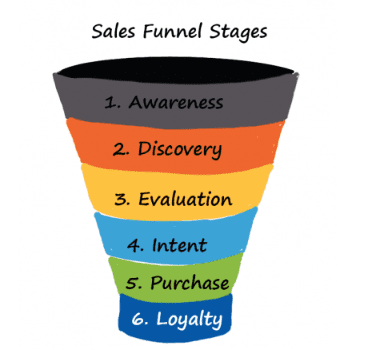
Q: What are the stages of a sales funnel?
The stages of a sales funnel typically include:
- Awareness: This is the stage where potential customers become aware of the existence of a product or service. They may become aware of it through advertising, social media, or other marketing channels.
- Interest: At this stage, potential customers are interested in the product or service and want to learn more about it. They may research the product, read reviews, or engage with the brand through social media or other channels.
- Consideration: At this stage, potential customers are considering whether to purchase the product or service. They may compare it to other products or services, evaluate the value proposition, and consider the price.
- Intent: At this stage, potential customers have decided to purchase the product or service and are ready to take action. They may add the product to their cart or complete a lead form to request more information.
- Evaluation: At this stage, potential customers evaluate their purchase decision before completing the transaction. They may review the details of their order, confirm the price, and check for any promotions or discounts.
- Purchase: This is the final stage of the sales funnel, where the customer completes the transaction and becomes a paying customer.
By understanding the stages of a sales funnel, businesses can optimize their marketing and sales strategies to guide potential customers through each step and increase the likelihood of conversions.
Q: How do you measure the success of a sales funnel?
To measure the success of a sales funnel, businesses can track key performance indicators (KPIs) at each stage of the funnel. Here are some common KPIs to track:
- Awareness: At this stage, businesses can track metrics such as website traffic, social media engagement, and brand awareness.
- Interest: At this stage, businesses can track metrics such as email open rates, content engagement, and social media followers.
- Consideration: At this stage, businesses can track metrics such as lead generation, demo or trial sign-ups, and content downloads.
- Intent: At this stage, businesses can track metrics such as cart abandonment rate, form completion rate, and quote or proposal requests.
- Evaluation: At this stage, businesses can track metrics such as average order value, upsell or cross-sell rates, and referral rates.
- Purchase: At this final stage, businesses can track metrics such as conversion rate, customer acquisition cost (CAC), and customer lifetime value (CLV).
By tracking these KPIs, businesses can identify areas of the sales funnel that need improvement and make targeted changes to optimize conversions and drive revenue. It’s important to regularly analyze the data and make data-driven decisions to improve the sales funnel over time.
Q: What are some strategies for building a high-converting sales funnel?
Here are some strategies for building a high-converting sales funnel:
- Know your target audience: Understanding your target audience is crucial for creating a sales funnel that resonates with them. Research your target audience’s demographics, pain points, and motivations to tailor your messaging and optimize your funnel for their needs.
- Provide valuable content: Provide valuable content that speaks to your target audience’s needs and pain points. This can include blog posts, videos, e-books, and webinars that educate and inform potential customers about your product or service.
- Optimize your website: Optimize your website to provide a seamless and easy user experience. This includes optimizing your website for mobile devices, creating clear calls-to-action, and using social proof such as customer reviews and testimonials.
- Nurture leads: Use targeted communications and automated email campaigns to nurture leads through the sales funnel. This can include providing personalized content and messaging that addresses their needs and pain points.
- Offer a free trial or demo: Offer a free trial or demo of your product or service to give potential customers a hands-on experience with your offering. This can increase the likelihood of conversions and drive revenue in the long term.
- Use retargeting ads: Use retargeting ads to reach potential customers who have already engaged with your brand but have yet to convert. This can increase brand recognition and encourage potential customers to complete their purchases.
By implementing these strategies, businesses can create a high-converting sales funnel that resonates with their target audience, provides a seamless user experience, and drives revenue in the long term.
Q: How do you optimize and test a sales funnel for maximum conversions?
To optimize and test a sales funnel for maximum conversions, businesses can follow these steps:
- Set clear goals: Define clear goals for your sales funnel, such as increasing conversion rates, reducing bounce rates, or increasing revenue. This helps you focus on the most important metrics and make data-driven decisions.
- Analyze data: Analyze data from each stage of the sales funnel to identify areas of opportunity for optimization. This includes website analytics, email campaign metrics, and conversion rate data.
- Implement targeted improvements: Implement targeted improvements to the sales funnel based on the data analysis. This can include optimizing forms, providing targeted messaging, social proof, and A/B testing.
- Use A/B testing: Use A/B testing to compare different variations of your sales funnel to determine which one performs better. This can include testing different messaging, calls-to-action, or page layouts.
- Optimize for mobile: Optimize your sales funnel for mobile devices, as more and more consumers use mobile devices to browse and purchase online.
- Continuously analyze and test: Continuously analyze and test your sales funnel to make ongoing improvements and ensure that it is performing at its maximum potential.
By following these steps, businesses can optimize and test their sales funnel for maximum conversions and drive revenue in the long term. It’s essential to use data-driven decisions and continuously analyze and test the funnel to ensure that it is optimized for the needs and preferences of the target audience.
- Success vs. Significance: Understanding the Difference and Achieving Both - October 1, 2023
- 8 Steps to SaaS Success: From Idea to Business - September 30, 2023
- The Importance of Testing in SaaS: Ensure Quality and Success - September 29, 2023